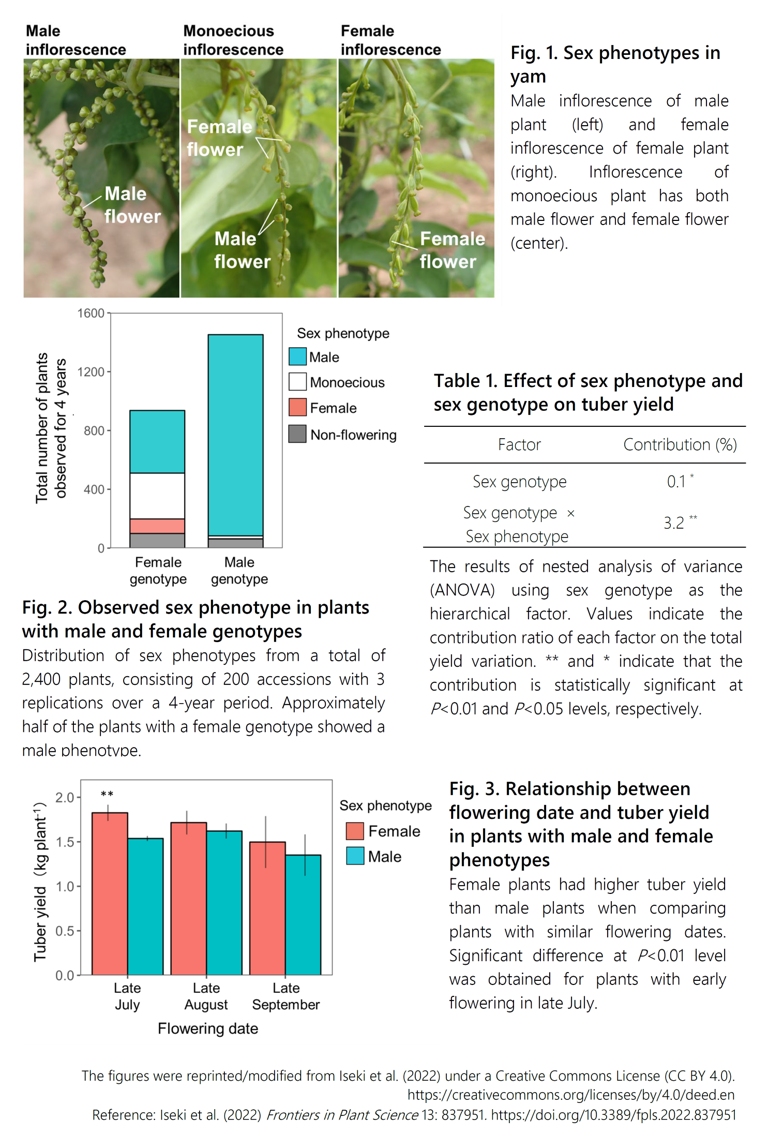Plant sex and flowering date are strong determinants of tuber yield in white guinea yam
Description
White Guinea yam (Dioscorea rotundata Poir.) is a tuber crop widely cultivated in West Africa, accounting for more than 90% of global yam production. The average annual yield of yam has been stagnant for decades and varies from year to year. Variability in tuber yield and yield-related traits has been observed even among plants of the same variety grown in the same environment. This study focused on the sex of yam flowers as one of the causes of unstable tuber yield, as flower sex has been known to interact with tuber yield. Yams are a dioecious species, with male and female flowers on different plants (Fig. 1). Moreover, plant-to-plant variability in flower sex expression is common in yam fields. A better understanding of the relationship between flower sex and tuber yield could be crucial for genetic improvement in yam breeding.
This study used F1-derived clonal progenies from a bi-parental cross to minimize the impact of basal genetic differences between the sex phenotypes. The impact of plant sex on agronomic traits, specifically tuber yield, was evaluated through field trials conducted for four years. The results showed that only plants with a female genotype exhibited diverse sex phenotypes (Fig. 2). Inter-plant variation in tuber yield was affected by both sex phenotype and sex genotype, but greater contribution to tuber yield was observed in the former than the latter (Table 1). Our results revealed that plants with female phenotypes had higher tuber yield than those with male phenotypes (Fig. 3). This result can be attributed to the fact that, compared to male plants, the low flowering intensity in female plants increases the availability of carbon resources for leaf development. The sexual differences in tuber yield were evident when comparing plants with similar flowering dates. Significant difference was observed for plants flowering in late July, but the difference became small for late flowering plants. This is because early flowering can avoid resource competition with tuber enlargement, which starts from mid-August.
Since sex phenotype varies with the surrounding environment in plants with the female genotype, artificial control of sex phenotype would be possible for yield improvement of female-genotyped varieties and could be achieved by appropriate field management, such as soil water control and arrangement of plant light interception, to maintain good culture conditions. The identification of the genetic factors and environmental conditions that determine flowering is currently underway, and it is expected to lead to new cultivation methods that improve tuber yield by successfully controlling flowering phenotype and flowering period, as well as the development of new varieties genetically modified for these traits.
Figure, table
- Research project
- Program name
- Term of research
-
FY2015–2022
- Responsible researcher
-
Iseki Kohtaro ( Biological Resources and Post-harvest Division )
Matsumoto Ryo ( International Institute of Tropical Agriculture )
ORCID ID0000-0002-0106-6728Olaleye Olajumoke ( International Institute of Tropical Agriculture )
Asfaw Asrat ( International Institute of Tropical Agriculture )
- ほか
- Publication, etc.
-
Iseki et al. (2022) Frontiers in Plant Science 13: 837951.https://doi.org/10.3389/fpls.2022.837951
- Japanese PDF
-
2022_B05_ja.pdf807 KB
- English PDF
-
2022_B05_en.pdf669.04 KB
* Affiliation at the time of implementation of the study.

